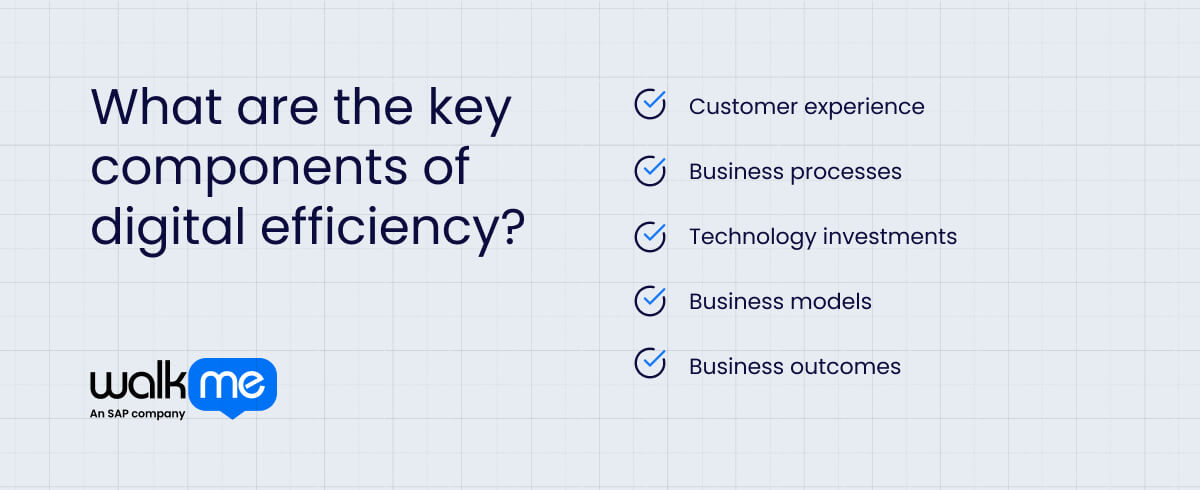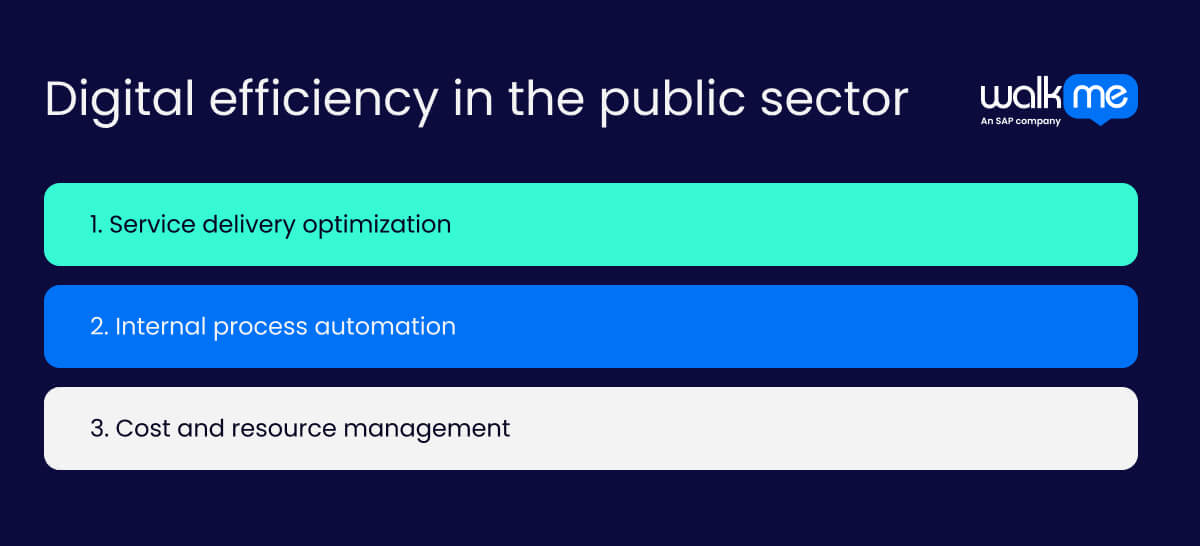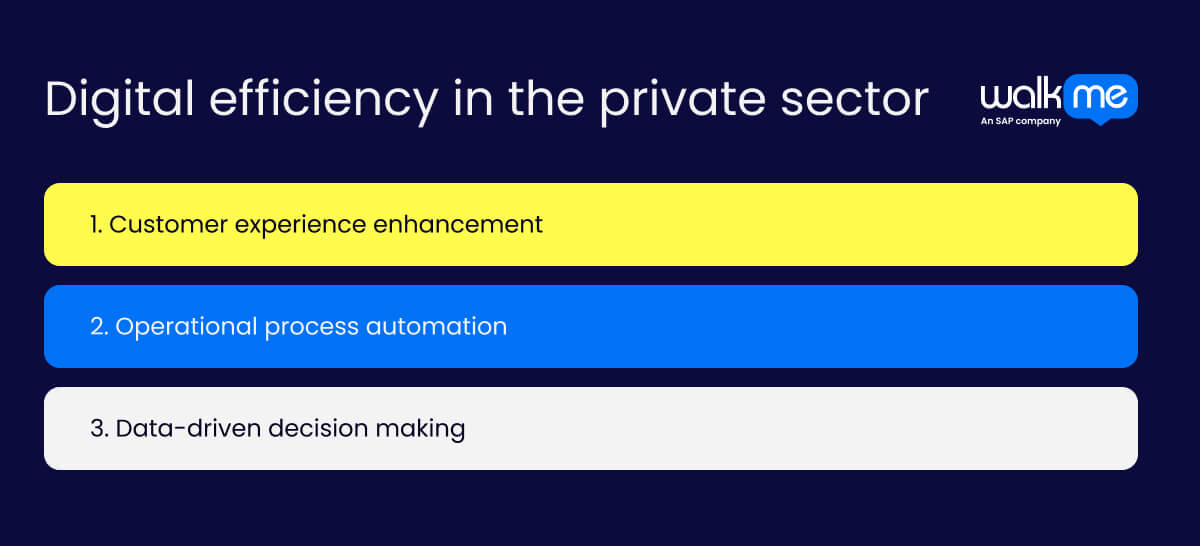What is digital efficiency?
Digital efficiency is the targeted use of technology to streamline operations, improve service delivery, and reduce waste.

In business, it means automating payroll with platforms, using AI to eliminate repetitive data entry in logistics procedures, or streamlining customer support with chatbots that resolve issues without human intervention.
For the U.S. government, it means replacing paper-based systems with cloud-native platforms to process all manner of public services, such as tax filings, benefits applications, and procurement workflows.
True digital efficiency focuses on doing fewer things better, using data and workflow automation to unlock more time, lower costs, and redirect energy toward high-impact work that improves outcomes for users and citizens.
Why is digital efficiency important?
Digital efficiency is important because it helps businesses get more done with less effort.
Reducing unnecessary steps means businesses can speed up operations, save time, and cut costs. The current pace of business operations demands organizational agility, and digital efficiency allows companies to stay competitive by quickly adapting to changes and responding to market needs.
Digital efficiency drives innovation by creating room for creativity and strategic thinking. When teams spend less time on manual tasks or managing disconnected systems, they can focus on solving complex problems and exploring new opportunities.
It has been proven that optimizing digital processes is crucial for improving digital efficiency and gaining a competitive advantage.
A recent study published on Emerald Insight highlights substantial disparities in digital efficiency among European nations, with an overall average of 46.36%, underscoring the potential benefits of digital optimization.
Focusing on digital efficiency allows businesses to cut through the noise of unnecessary complexity. Streamlined processes enable quicker decisions, smoother collaboration, and faster responses to shifting market demands.
Digital efficiency vs. digital transformation
Digital efficiency and digital transformation may seem interchangeable, but they address different aspects of a business’s operations. While both are important, understanding their distinct roles can clarify their impact.
Let’s take a quick look at how the two terms differ:
Digital efficiency
Digital efficiency focuses on refining existing processes. It examines where resources are wasted and seeks ways to optimize day-to-day operations. This involves removing unnecessary steps, automating tasks where possible, and ensuring that existing systems are working at their full potential. The goal is to get more out of the current setup without needing a massive change.
Digital transformation
Digital transformation, however, is about overhauling how a business operates by introducing new technologies and systems. It goes beyond tweaks and considers rethinking entire workflows or adopting new tools that may replace older practices entirely. It’s a broader shift aimed at making the business more adaptable in the long run.
Remember that efficiency tightens current processes, and transformation reshapes them for the future. Both play a role, but knowing when each is needed can make all the difference.
What are the key components of digital efficiency?

Now that you understand digital efficiency, why it’s important, and how it differs from digital transformation, it’s time to look at its key components.
Understanding the key components of digital efficiency is the best way to identify areas within your business that can be improved for better results.
Let’s take a closer look at the key components of digital efficiency:
Customer experience
When customers interact with a business, their experience should be quick and easy. If the process is slow or confusing, they’ll get frustrated. Digital efficiency makes the process smoother by eliminating unnecessary steps and making it easier for customers to complete what they need. For example, investing in a simple and fast website or app improves the user experience. Customers are happier and more likely to return when things work in tandem.
Business processes
Business processes are the steps teams take to complete tasks. If these steps are too complicated or slow, it wastes time and resources. Digital efficiency removes unnecessary steps, making the approach faster and more accurate. Even automating some of the daily tasks or organizing procedures more clearly can help businesses work smarter, not harder. This saves time, reduces errors, and allows employees to focus on long-term strategy.
Technology investments
When businesses buy new technology, it should solve a problem, not add more confusion. Digital efficiency focuses on choosing tools that consolidate workloads. The right technology should help teams communicate more quickly, store data more effectively, and easily track tasks. Tools that are too complicated or don’t fit well with existing workflows slow everything down. The goal is to invest in technology that meets the business’s needs and helps people perform their jobs more effectively.
Business models
A business model is how a company creates and delivers value to its customers. Digital efficiency changes these models by removing unnecessary stages in providing products or services. For example, automating certain tasks or switching to online sales can speed up the process and cut costs. Businesses that adapt to digital solutions can be more flexible and quicker in delivering what customers want. Reducing unnecessary steps saves time and allows companies to focus on expansion.
Business outcomes
Digital efficiency helps businesses run more efficiently, with faster operations and better results. When digital tools and processes are optimized, companies can do more with less effort. This leads to better results, such as completing projects on time, saving money, and enhancing teamwork. Businesses can track how much time or money they save, showing how much more effective they’ve become.
Digital efficiency in the public sector

Now that we’ve discussed the main components of digital efficiency, it’s time to examine its effect on the public sector.
The Department of Government Efficiency (DOGE) in the United States is leading the way. It is the first of its kind to garner widespread attention and scrutiny from the public.
Its focus on optimizing digital systems and cutting bureaucracy is sparking much-needed change, making government services more efficient, responsive, and accessible.
Let’s take a closer look at public sector digital efficiency:
Service delivery optimization
In the public sector, digital efficiency helps improve how government services are delivered to people. According to McKinsey, focusing on service delivery and using flexible work arrangements can help government agencies move beyond small improvements and lead to real, lasting change.
Automation technology also helps agencies respond faster and more fairly, making it easier for individuals to access services like healthcare, permits, or information. These improvements make public services more reliable and useful for both the government and the people who rely on them.
Internal process automation
Government departments often deal with large amounts of paperwork and repetitive tasks. Internal business process automation helps eliminate these manual jobs. Instead of employees spending hours on routine tasks, automated systems handle them quickly and without mistakes.
Workers are then free to focus on tasks like helping citizens or solving complex problems. Automation improves efficiency in government offices, ensuring that procedures are completed faster and more accurately without incurring extra costs or time.
Cost and resource management
Digital efficiency helps public sector organizations manage resources and costs more adeptly. With new-age tools, governments can track how money is spent and where resources are used. These tools make it easier to identify areas that need more attention and where money can be saved.
Government agencies can also plan for unexpected changes, ensuring they use their funds wisely. Instead of wasting time and money on outdated processes, digital efficiency helps governments cut unnecessary costs while still providing the essential services that people need.
Digital efficiency in the private sector

Now that we’ve covered private sector digital efficiency, it’s time to unpack how the private sector uses these practices to stay competitive, reduce waste, and enhance customer experiences.
Private sector companies have been the gold standard for implementing effective digital efficiency initiatives. SaaS companies have led the way by developing cloud-based solutions that enable rapid scaling of operations.
Their focus on continuous iteration and data-driven insights allows them to identify inefficiencies quickly and address them in real-time.
Let’s take a closer look at private sector digital efficiency:
Customer experience enhancement
In the private sector, Companies have long used technology to enhance customer experiences. For example, online stores and banking apps use artificial intelligence (AI) to offer personalized recommendations based on what customers like or need.
SaaS companies, like cloud services, constantly improve their platforms by listening to customer feedback. This helps them create better products and offer faster support. Using digital tools, companies can better understand their customers, solve problems quickly, and make interactions smoother.
Operational process automation
Many industries use automation to make their operations more efficient. SaaS companies automate tasks like managing customer support tickets or handling data. Other sectors, such as manufacturing and healthcare, also use automation to speed up tasks, like scheduling or tracking inventory.
With AI, companies can predict and prevent problems before they occur, saving time and reducing errors. This allows businesses to do more with less effort, keeping procedures running smoothly without adding unnecessary costs.
Data-driven decision making
In modern business, companies use big data analytics to make smart decisions. Technology firms, in particular, use data to improve their products, like adding new features or fixing bugs. Retail businesses use data to recommend products to customers or figure out how much stock to keep.
Financial companies use real-time data to make investment decisions. Big data helps businesses identify trends, spot problems early, and discover opportunities they might have otherwise missed. The quicker they can use this information, the better they can perform and stay ahead of the competition.